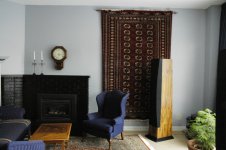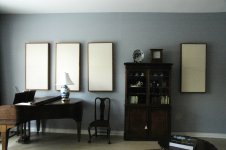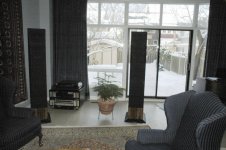as seen also within this thread, the stereo triangle cannot deliver perceivable phantom images at high freqs for 50 % of the population but two tweeters are perceived as separate sound sources !
The facts have been put on the table, conventional stereo triangle sucks for 50 % of the population. Still no one is motivated to address this issue in the stereo loudspeaker design in terms of what is the ideal directivity pattern for a stereo speaker !? Cannot believe this !
- Elias
Member
Joined 2003
My message would be "stop joking around, get surround sound."
+++
Preference for "you are there" or "they are here" is not something you just make as a decision, but it naturally follows as a consequence from your favourite music genre.
- Elias
I think that this is true to a very large extent. I believe that the larger the venue in terms of # of instruments and room size the more problematic the small room situation becomes and the less likely we are to ever get to "realism". Fortunately my tastes have always gone to the small clubs, more private settings and I find that my system does these exceptionally well. I don't dislike classical music, but I do find it unsatisfying at home. I love to see it live, because then it works! But I get my fill on these somewhat infrequent occasions. But even live, when I last saw Messiah (kind of an annual event) I closed my eys and there was no "image". I could not identify individual instruments or even the soloists. It certainly was not the more intimate small venue experience.
I tuely believe that one can get a great "they are here" experince with optimization of the sources and the room and that this will work OK for the "you are there" situations, but optimizing for the "you are there" situations will basically kill the "they are here" ones.
Movie mix down studios have a standard, unlike with musical formats. This tends to make the sound much more consistant than you find on CDs.
'you are there in a dream' could be also called 'you are looking at there trough a window(and still sitting in a small, dead room)'.
I also agree that realistic 'you are there' is not possible with regular 2ch playback, envelopment(like a good concert hall has) is missing.
WFS, (higher-order)ambisonics, binaural, partially even regular multichannel could get you 'there'.
I also agree that realistic 'you are there' is not possible with regular 2ch playback, envelopment(like a good concert hall has) is missing.
WFS, (higher-order)ambisonics, binaural, partially even regular multichannel could get you 'there'.
Elias, I think you are getting my sense of humor.
On a serious note(intentional pun), stereo is nice b/c it doesn't exclude my friends especially when crossfired. I'm not really a lone wolf all the time. I prefer the pack-hopefully packing instruments. Some people don't enjoy that sort of thing. It's certainly understandable.
So maybe another dichotomy is in order: Lone Wolves vs. Socialites.
Dan
On a serious note(intentional pun), stereo is nice b/c it doesn't exclude my friends especially when crossfired. I'm not really a lone wolf all the time. I prefer the pack-hopefully packing instruments. Some people don't enjoy that sort of thing. It's certainly understandable.
So maybe another dichotomy is in order: Lone Wolves vs. Socialites.
Dan
Member
Joined 2009
I don't dislike classical music, but I do find it unsatisfying at home. I love to see it live, because then it works! But I get my fill on these somewhat infrequent occasions. But even live, when I last saw Messiah (kind of an annual event) I closed my eys and there was no "image". I could not identify individual instruments or even the soloists. It certainly was not the more intimate small venue experience.
I believe an orchestra makes available not only a wide range of different sounds and dynamics but also a spatial texture to the sound. A musical arrangement may not just change tones but also enable the sound to float in space a certain way. The position of the members of an orchestra should be taken in account when composing and recreating a musical piece so that the desired acoustic picture is painted in space accordingly.
Of course, I don't think many classical performances achieve that and not all pieces were written in a way to take advantage of it.
The short answer is that it depends on the listening room acoustics and the preferences of the listener to have either directivity patterns optimized for maximum clarity of imaging cues embeded in the program material (likely to be best for a single listener), or a more diffuse sound that sounds more consistent outside of the sweet spot (may be better for those who often have company over).The facts have been put on the table, conventional stereo triangle sucks for 50 % of the population. Still no one is motivated to address this issue in the stereo loudspeaker design in terms of what is the ideal directivity pattern for a stereo speaker !? Cannot believe this !
- Elias
The best way to determine what a given person will be happy with is to hook them up a nerdometer, and if the needle barely moves go wide and preferably even dispersion, if the needle goes high or smoke comes out of the meter and the needle breaks, go with controlled directivity, and possibly even an inter-aural cancellation circuit. Yes, it's true. I blew the meter, smoke and all. 😎
Member
Joined 2009
My message would be "stop joking around, get surround sound."
😛
Dan
Surround sound is great for video games and some movies. But you must be the one joking around if you suggest it for music. How is the addition of more channels going to help the problem with room? The addition of more than 3 channels will not give a coherent phantom image and will only make things worse. You will know which direction sounds are coming from but everything will sound bad.
The only way a music recording can sound good on multiple channels is when each instrument is recorded on a dedicated channel.
Preference for "you are there" or "they are here" is not something you just make as a decision, but it naturally follows as a consequence from your favourite music genre. Most music genres have settled recording practises, as well as performance places. Some music genres fits only into the either or and does not sound right if tried to fit into 'wrong' camp.
Conventional stereo is incapable of doing mostly anything, as seen also within this thread, the stereo triangle cannot deliver perceivable phantom images at high freqs for 50 % of the population but two tweeters are perceived as separate sound sources ! Stereo horse is born dead but running wild !
Conventional stereo is going down like a cow's tail ! Due to this enormous unsatisfaction people keep on inventing improved underground practises like Ambiophonics, stereolithic projection, 'flooders', Beveridge placements, Carlssons, etc. etc.
Multichannel is not needed ! Two media channel is perfectly enough for the two ears. More media channels is just a waste of bandwidth. It is all about how to generate and present the ear signals from the two media channels. Som systems are more succesfull than others. Note: Two media channels does not mean two loudspeakers ! They are independent.
my thoughts exactly
Elias, what about 4, 6, or 8 ears?
Oh, and stereo is definitely capable of "sounds good" 😉
Dan
nah, it is just capable of "sounds good TO" (eg. You) 😉 😀
I think the best might be to use single mono speaker for the direct sound, and multiple other speakers (decorrelated) at side and back for ambiance enhancement ! No stereophonic artefacts ! 
- Elias

- Elias
Surround sound is great for video games and some movies. But you must be the one joking around if you suggest it for music. How is the addition of more channels going to help the problem with room? The addition of more than 3 channels will not give a coherent phantom image and will only make things worse. You will know which direction sounds are coming from but everything will sound bad.
I think surrounds are great for adding ambiance, if that's what you want. Some don't want it, others do. Different strokes for different folks.
But I do think that if you do want envelopment, then there's only two ways to get it. One is to make a simulated sound field from lots of reflections in a lively room. The other way is to record things at each side and present them in surround channels. More microphone channels, more ability to capture spatial information.
The short answer is that it depends on the listening room acoustics and the preferences of the listener to have either directivity patterns optimized for maximum clarity of imaging cues embeded in the program material (likely to be best for a single listener), or a more diffuse sound that sounds more consistent outside of the sweet spot (may be better for those who often have company over).
I agree, absolutely.
The best way to determine what a given person will be happy with is to hook them up a nerdometer, and if the needle barely moves go wide and preferably even dispersion, if the needle goes high or smoke comes out of the meter and the needle breaks, go with controlled directivity, and possibly even an inter-aural cancellation circuit. Yes, it's true. I blew the meter, smoke and all. 😎

Boris, for all my music not made for surround, I just go with stereo. IOW,what it was intended for.
My Nerdometer broke on "nope" I guess. he he. Not really though--I love my headphones and binaural recordings as well. I even make binaural recordings of my system in stereo and surround sound. Okay, I might be a nerd.
You know Graaf it's funny, I have you on my ignore list, but I thought I'd read one of your posts just for kicks. I didn't realize I was the only one who enjoyed stereo. Perhaps I am a lone wolf. Ahhh, too funny.
Dan
My Nerdometer broke on "nope" I guess. he he. Not really though--I love my headphones and binaural recordings as well. I even make binaural recordings of my system in stereo and surround sound. Okay, I might be a nerd.
You know Graaf it's funny, I have you on my ignore list, but I thought I'd read one of your posts just for kicks. I didn't realize I was the only one who enjoyed stereo. Perhaps I am a lone wolf. Ahhh, too funny.
Dan
Last edited:
You are expecting that somehow the recordings "acoustic" will out-shine that of the local space. That simply cannot happen. If there are reflections and reverberation in the local space then they are way too short to not overcome and/or confound the recordings acoustic.
Have You really never heard the walls disappearing act?
Are You sure that the earlier room reflections override the later recorded reflections and not the other way round? Is there any science behind Your conviction?
Last edited:
Member
Joined 2009
Boris, for all my music not made for surround, I just go with stereo. IOW,what it was intended for.
My problem is with multichannel music disks. How are they recorded and what are they supposed to do exactly?
To me it comes down to this: the "you are there" never works, how can it? (Standard two channel playback assumed here!) You are expecting that somehow the recordings "acoustic" will out-shine that of the local space. That simply cannot happen. If there are reflections and reverberation in the local space then they are way too short to not overcome and/or confound the recordings acoustic. If the room is deadened to remove these VERs then there are no lateral reflections and no spaciuosness because the acoustic on the recording comes from the wrong direction to be convincing. The "you are there" illusion just cannot happen with two channels in real rooms.
There is no need one to "shine" over the other. A concert hall acoustics can be simulated by creating interaural fluctuations in the 10-20Hz modulation bandwidth. This can be done in a small room.
Your stereo phantom imaging, it is not real, it is a simulation as well.
- Elias
I just tried a calculation for my small room with a mean Alpha of 0.4 to see what it would give.
Length is 4.8m, width 3.45m, height 2.4m, which gives a volume of 39.744m^3, and a surface area of 72.72m^2. Using the sabine equation I get 0.22s.
The room is at about 0.4ms now and sounds a bit too live to me, (I prefer the drier end of the scale) but 0.22 seems quite low, unless I've calculated it wrong ? Mind you, this is the smallest listening room I've ever had, so I'm basing my expectation on somewhat larger rooms.
My 0.4 alpha number is probably a little misleading in that it is a number I've found works for a well treated commercial theater of any size. It is probably significantly higher than the typical living room, although a purpose built listening room or home theater could easily hit it.
My living room is 96m cubed and has a mean alpha of .17 with the drapes open (0.69 secs. with Sabine equation) and alpha of .21 with drapes shut (.57 secs RT). An alpha of 0.4 would give .3 secs RT. These calculated RTs are with a spreadsheet model. Using CATT acoustics, a ray tracing program gave .5 secs drapes open and .42 sec drapes shut. Measurements are closer to the CATT acoustics numbers.
Even with some significant damping material I am probably only neutralizing the hardwood floors and thin oriental rugs.
I've attached some pictures plus an image of the computer model, for anybody interested.
David S.
Attachments
Dr Geddes said :
Maybe 20 years ago, I've been lucky enough to assist to a demo organized by La Maison de l' Audiophile in Paris. This was taking place in a small concert hall nearby, not a very reverberant acoustic, 100 spectators at least, seats in terrace style.
The system was the big fashionable "esoteric" one of these times : 2x 15" Altec plus horns (huge multicellular, smaller one, tweeter), passive filter, not the simplest attempt of time alignment, probably measured once...or maybe never. Amps were ridiculous tiny SE valve, with components costing one arm. Hiraga was behind this.
The results were at the hallucinatory level, let's forget these poor man's notions of spaciousness, pin pointed imaging, phantom image, envelopment, dynamic range, as "they are here" or "I am there". Just the cracks of the vinyl were absolutely indecent at this level of realism.
This was not even a 60° triangle, more 20° to 30° for the majority of the listeners. I dunno what was the most important factor : the system or the plausible space (plausible for a concert). Since this blessed day, I do my best to have a huge room.
Yes, of course. Playing back an orchestra in the same room that it was recorded in (a "dry" recording, of course) and I am sure that the realism would be profound. But thats not "reality" - its not going to happen.
Maybe 20 years ago, I've been lucky enough to assist to a demo organized by La Maison de l' Audiophile in Paris. This was taking place in a small concert hall nearby, not a very reverberant acoustic, 100 spectators at least, seats in terrace style.
The system was the big fashionable "esoteric" one of these times : 2x 15" Altec plus horns (huge multicellular, smaller one, tweeter), passive filter, not the simplest attempt of time alignment, probably measured once...or maybe never. Amps were ridiculous tiny SE valve, with components costing one arm. Hiraga was behind this.
The results were at the hallucinatory level, let's forget these poor man's notions of spaciousness, pin pointed imaging, phantom image, envelopment, dynamic range, as "they are here" or "I am there". Just the cracks of the vinyl were absolutely indecent at this level of realism.
This was not even a 60° triangle, more 20° to 30° for the majority of the listeners. I dunno what was the most important factor : the system or the plausible space (plausible for a concert). Since this blessed day, I do my best to have a huge room.
- Status
- Not open for further replies.
- Home
- Loudspeakers
- Multi-Way
- What is the ideal directivity pattern for stereo speakers?



